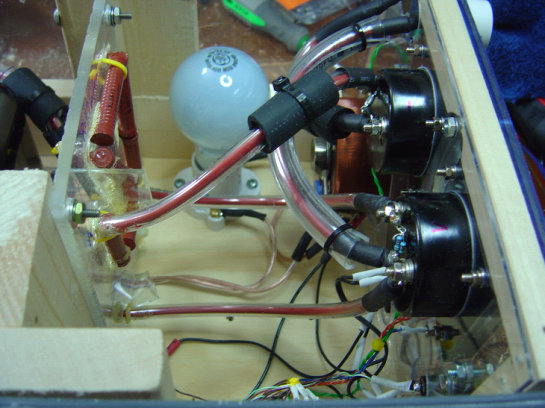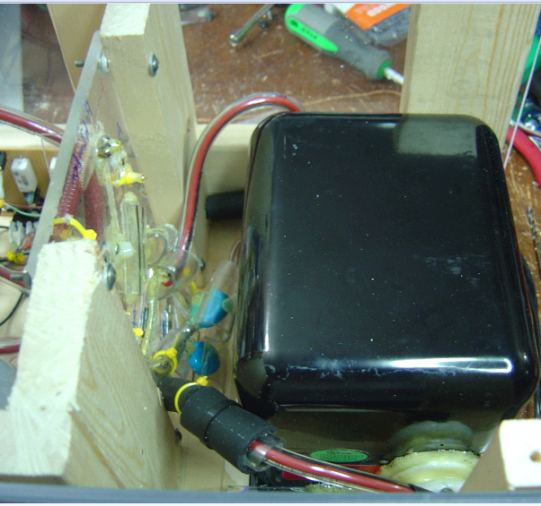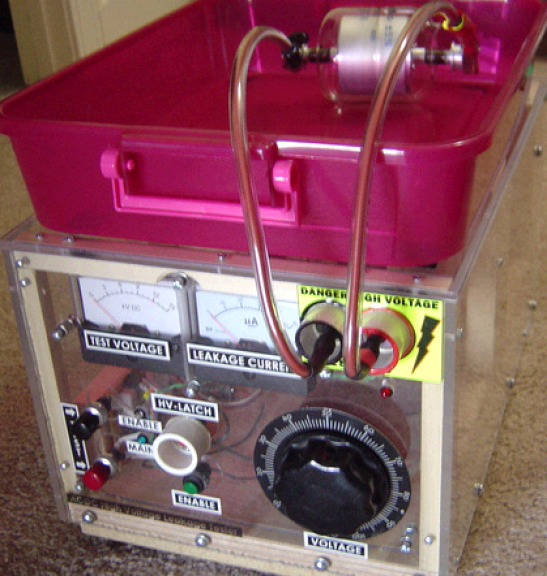 The only way to be sure is to test it... The only way to be sure is to test it...
I built this hi-pot leakage tester in preparation for the tank overhaul on the SB200 project. With so much stuff in such a small space, arcing can happen in a lot of places and in many cases, be blocked by components so it's not readily observable. So it's something that needs to be proactively tested for. The hi-pot tester is the way to do that safely. The beauty of the hi-pot tester is that the current is controlled. You encourage the leakage through high voltage, but when an arc occurs (or the onset of an arc which you can measure), the limited current prevents damage from occurring. I really should have built this device before starting on the amp, in retrospect. This design is a hybrid of ideas. For other examples of well documented and well constructed testers see: Rich Measures AG6K: http://www.somis.org/BVT.html BIll Jones K8CU: http://www.realhamradio.com/High_Voltage_Breakdown_Tester.htm IMPORTANT NOTE: Construction and use of all high voltage devices including leakage measuring devices like this CAN KILL. It only takes one mistake to put you in the grave. Schematic - click here to download PDF This unit will test in excess of 15KV due to the large filter cap and step-up capability of the variac. With careful attention to leakage paths, this level is achievable without significant leakage currents (under 1 uA). The front panel is a double wall Plexiglas construction. The meters leak and the Plexiglas - at about 90KV/mm - provides great insulation. The base of the structure is 3/4" plywood although none of the components in the chain are in contact with the wood directly. The exterior is 1/4" Plexiglas. The LEDs shown inform the operator when AC power is applied to the tester (so be careful), another light applies power to the final switching (another safety measure) and then both of the "TEST" buttons must be pushed at the same time for output voltage to show across the connections. The idea is you need one hand on the voltage setting dial and the other hand on the test buttons - which leaves no hands for you to accidentally get over to the DUT. I thought that there may be instances where I wanted to keep the HV on the tube over a long period of time. So included is a latch button which will keep the output voltage applied and that switch is guarded by the PVC pipe to prevent accidental engagement. The meters are 50 uA movement sourced on eBay from a Hong Kong vendor. The left meter for applied voltage has been customized with the Meter program from Tonne software. Accuracy is within a couple of uA indicated and about 500V of mid-scale indicated. As leakage current increases, the indicated voltage is slightly less than actual due to the small but finite voltage drop across the series connected dropping resistors. There are no regrets in the build other than I do have a small bit of leakage between the meters. I suspect there is some carbon black content in the black plastic which makes the material ever so slightly conductive at extreeme voltages. This is behind the Plexiglas and is not a threat to the user. And some added insulation material could be placed in the gap between the meters but the leakage is trivial and adding the insulation would detract from an otherwise pretty clean look. However, if I were to build again, I would simply space the meters a bit further apart. The lesson from that is that leakage will exist in any place where things are close together. Even things that do not seem that they should, seem to have the risk of leakage... 
All wires are #18 silicone insulated high voltage wire rated at 20KV. In addition, each of these wires is encased by the flexible plastic tubing - and the ends are covered with heat-shrink tubing. At intersections where HV wire leads do come into proximity, a 3rd layer of insulation (black jacket shielding from RG-213) is wrapped and secured. That combination ensures that no wire sourced leakage is likely. The greatest voltage differential point is on the Plexiglas sheet in the center where the bridge rectifier is located. Bridge is built from diodes rated at 20KV, 40ma and the filter caps are 20KV. Both sourced from Chinese vendors off eBay. Resistors are NOS from the Ukraine - rated at 8KV. Connection points are soldered with large rounded blobs of solder to cut down on the chance of corona. And then coated with the epoxy-like glue to reduce air contact. The numerous plastic ties used are to ensure that the unit, when sitting unused over a long period of time, does not have component settling such that previously non contacting wires may settle to become adjacent, etc. 
The light bulb serves as an additional current limiter. And is a good visual indication of leakage current pickup over and above the front panel meter reading. 
The ignition transformer is rated at 10KV, 22ma. It's mounted on a 1/8" Plexiglas sheet to insulate it from the wood base. The wood is a good insulator but I did not want to worry about inadvertent moisture pickup as a "shocking surprise." Even at maximum voltage, the unit exhibits no corona or other leakage except in one location - the HV tap on the transformer. Unfortunately the output is potted and the insulator is not removable. So my solution was to apply a layer of epoxy-like glue to the connector and that did a very good job of suppressing the leakage. 
In use, the unit has this red colored plastic basket on top. That serves two functions. It holds the test leads when not in use. And also provides a safe high-voltage insulated platform to hold the DUT. The feet are elevated in the front, so the DUT tends to roll back away from the front of the unit which keeps the test leads taught - and away from the operator without further tending. Shown below are over-sized test leads applied to a 15KV vacuum cap. 
|